Rising from the heart of the Tularosa Basin is one of the world's great natural wonders - the glistening white sands of New Mexico, USA. Here, great wave-like dunes of gypsum sand have engulfed 275 square miles of desert and created the world's largest gypsum dune field.
Gypsum is rarely found in the form of sand because it is water-soluble. Normally, rain would dissolve the gypsum and carry it to the sea. Since the Tularosa Basin has no outlet to the sea, rain that dissolves gypsum from the surrounding San Andres and Sacramento Mountains is trapped within the basin, and the rain either sinks into the ground or forms shallow pools which subsequently dry out and leave gypsum in a crystalline form, called selenite, on the surface.
The wind moves small sand grains by bouncing them along the surface in a process called "saltation." Saltating sand grains create a beautiful pattern of ripples on the dune surface. Larger sand grains are struck by saltating grains and slowly roll forward, a process known as "surface creep."
West of Alamogordo, a vast area of desert and mountain ranges 100 by 40 miles in extent is closed to public access and used by the military for various kinds of weapons testing; this includes the Trinity Site where the first atomic bomb was detonated, in July 1945. Determined tourists may visit on two days each year, the first Saturdays of April and October, when accompanied tours are provided. The only other feature of interest in this otherwise desolate and unwelcoming land is 60 miles south in the flat Tularosa Basin, where for thousands of years the prevailing westerly winds have deposited gypsum powder - formerly eroded from the nearby San Andres Mountains, washed down by rainwater and deposited in the seasonal Lake Lucero, a few miles southwest - creating a huge area of white dunes covering 275 square miles. About half of the sands are within the boundaries of the White Sands National Monument, one of the most unusual and magical places in the Southwest.
 |
| Gypsum mound |
A mound of compacted gypsum, stabilized by the roots of the bushes on top - once in the middle of a dune, now surrounded by a small crater. Near the Interdune Boardwalk Trail, close to the southeast edge of the dunes in White Sands National Monument.
 |
| Soaptree Yucca Growing in Gypsum Sand link |
Some species of plants can survive burial by a moving dune by a process called "stem elongation." As the sand rises, the plants quickly grow upward to keep their leaves above the rising sand.
 |
Early morning sun on a group of yucca elata (soaptree yucca), San Andres Mountains in the distance. |
 |
Several lizard species that are dark have developed white skin in the White Sands of New Mexico
link |
White Sands National Monument preserves a major portion of this unique dune field, along with the plants and animals that have successfully adapted to this constantly changing environment.Three species of lizards, one pocket mouse and numerous species of insects have evolved a white coloration for survival in the white sands.White Sands National Park has amazing sand dunes. Some of these are over 40 feet tall. Dunes may take many forms, depending on the amount of sand available, the strength and direction of prevailing winds, and the type of vegetation in the area. Four types of dunes can be found in the white sands dune field.
 |
| This was shot at White Sands National Park in July 2007 link |
The white sands dune field is an active dune field. The dunes move from west to east as much as thirty feet per year.
 |
| Sunset at White Sands link |
Only a handful of gypsum dune fields exist and the white sands dune field is by far the world's largest, covering 275 square miles.
At times the National Park Service actually has to plow the road to keep it clear of the ever shifting sand dunes. As the road enters deep into the park it is dyed completely white due to the surrounding sand dunes.
 |
| Eroded ridges of compacted gypsum |






















.jpg)




i like them all!..
ReplyDelete